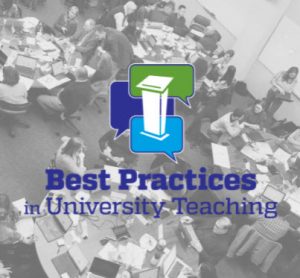This summer, the Center for Educational Resources offered a multi-day Best Practices in University Teaching workshop for JHU faculty to learn about evidence-based teaching practices. Participants explored topics such as best practices in course design, active learning strategies, and various assessment techniques.  One of the many sessions that generated a great deal of discussion was the Inclusive Pedagogy session, which addressed the importance of accommodating the needs of diverse learners in a supportive environment. The session was led by Dr. Karen Fleming, a professor in the Biophysics department who is also nationally recognized for her efforts in raising awareness on overcoming biases and barriers to women in STEM. I played a small role in the presentation by providing a brief introduction and overview of Universal Design for Learning (UDL), a research-based educational framework that helps remove unnecessary barriers from the learning process.
One of the many sessions that generated a great deal of discussion was the Inclusive Pedagogy session, which addressed the importance of accommodating the needs of diverse learners in a supportive environment. The session was led by Dr. Karen Fleming, a professor in the Biophysics department who is also nationally recognized for her efforts in raising awareness on overcoming biases and barriers to women in STEM. I played a small role in the presentation by providing a brief introduction and overview of Universal Design for Learning (UDL), a research-based educational framework that helps remove unnecessary barriers from the learning process.
During the session, participants were encouraged to examine their own biases by reflecting on an unconscious bias test they took just before the session. Many were clearly dismayed by their own results; Fleming reassured them that we all have biases and that accepting this fact is the first step in addressing them. She then shared a real-world example of unconscious bias toward women in STEM that is published in the Proceedings of the National Academy of Sciences. The shocking results of this study, which show that even women faculty in STEM display a preferential bias toward males over females, resulted in an engaging discussion. The dialogue continued as participants then debriefed about a video they watched, also before the session, which featured a teaching assistant (TA) stereotyping various students as he welcomed them to class. The video was intentionally exaggerated at times, and participants were eager to point out the “over the top” behavior exhibited by the TA. Participants were inspired to share personal experiences of bias, prejudice, and stereotyping that they’ve encountered in the classroom either as students or instructors.
Toward the end of the session, the focus shifted to thinking about strategies that would mitigate instances of biased behavior and instead encourage a more inclusive classroom environment.  As a culminating exercise, we asked participants to consider the principles of UDL as well as ideas and discussions from earlier in the session to complete an “Inclusive Strategies Worksheet;” the worksheet would contain concrete strategies that would make a measurable difference in terms of inclusivity in their classrooms. The participants were very thoughtful in their responses and several of their ideas are worth sharing:
As a culminating exercise, we asked participants to consider the principles of UDL as well as ideas and discussions from earlier in the session to complete an “Inclusive Strategies Worksheet;” the worksheet would contain concrete strategies that would make a measurable difference in terms of inclusivity in their classrooms. The participants were very thoughtful in their responses and several of their ideas are worth sharing:
- Administer a pre- or early-semester survey to get to know the students and build community.
- Include a “campus climate” section in the syllabus with language expressing a commitment to respecting diverse opinions and being inclusive.
- On the first day of class, have students create a “Community Agreement” to establish ground rules for class discussions, online discussions, and group activities. This can be revisited throughout the semester to adjust what is working/not working.
- Acknowledge that there may be uncomfortable moments as we face mistakes and hold each other and ourselves accountable. Encourage students to “call in” when mistakes (intentional or not) occur, rather than “call out” or “cancel” so that we may learn from each other.
- Work collaboratively with students to develop rubrics for assignments.
- Include authors and guest speakers with varied cultures, backgrounds, and identities. Include images, readings, examples, and other course materials that are diversified. If opportunities are limited, have students do a reflective exercise on who/what is missing from the research.
- Share content with students in multiple ways: research papers, videos, images, graphs, blog entries, etc.
- Increase the number of active learning activities to enrich the learning experience.
- Offer options to students: vary the types of assignments given and allow for a choice of ways to demonstrate knowledge among students when possible.
- Follow accessibility guidelines: ensure video/audio recordings have closed captioning and/or a transcript, for example.
- Create opportunities for students to discuss their lived experiences in the classroom and/or on assignments.
- Provide opportunities for students to participate anonymously without fear of judgement (i.e. using iClickers or Jamboard).
- Conduct activities that engage students in small groups so they get to know one another. Encourage students to use these connections to identify study partners. Consider switching groups throughout the semester so students meet additional partners.
Do you have additional strategies to share? Please feel free to add them in the comments.
Amy Brusini, Senior Instructional Designer
Center for Educational Resources
Image Source: Best Practices in University Teaching Logo, Pixabay

When will this course be offered again?
The next time this workshop will be offered will be in January, 2022.